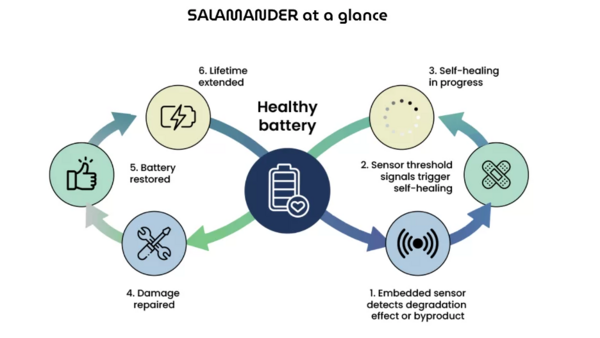Salamander
| SALAMANDER | |
|---|---|
| ID | OSW1798fc130102418e9a8d67dea7f53ff3 |
| UUID | 1798fc13-0102-418e-9a8d-67dea7f53ff3 |
| Label | SALAMANDER |
| Machine compatible name | Salamander |
 |
|
| Statements (outgoing) | |
| Statements (incoming) | |
|
|
|
Description
An EU Horizon Europe research project and part of the Battery2030+ initiative
| Item | |
|---|---|
| Type(s)/Category(s) | Project |
| Project | |
|---|---|
| Type | Public |
| Grantor | |
| Funding call | |
| Grant ID | |
| Start | 2023-05-01 |
| End | 2026-10-31 |
| Budget | 0.0e+0 |
| OU | Uppsala University, National Institute of Chemistry, Institute for Energy Technology, IFE Invest AS, University of Oslo, Basque Center for Macromolecular Design and Engineering, Polykey Polymers SL, Asociación Instituto Tecnológico de la Energía, Fraunhofer Institute for Solar Energy Systems ISE, Universidad Del Pais Vasco, University of Warwick, Univerzita Pardubice |
| Project manager | Samson Yuxiu Lai |
| Member | Samson Yuxiu Lai, Inger-Emma Nylund, Nienke Visser |
Abstract
With the increasing reliance on Li-ion batteries (LIBs) to power our devices and facilitate the transition to renewable energy sources, the pressing problem of their limited lifespan and environmental impact looms large. LIBs degrade over time, and their production generates significant carbon emissions. In this context, the EU-funded SALAMANDER project offers a groundbreaking solution to these challenges. Specifically, it aims to embed advanced sensors and self-healing capabilities within LIBs, creating smart batteries that can autonomously detect and repair damage. This innovative approach not only promises longer-lasting, more reliable batteries but also aligns with the goal of a sustainable European battery value chain and a greener future.
Project Overview
The salamander is well known for its ability to self-heal, regenerating damaged limbs into fully functional body parts, increasing the salamander’s lifetime. Inspired by this natural property, the project proposes a disruptive approach to design a rechargeable battery with “smart” functionalities; specifically, a self-healing functionality embedded directly into the electrode which is triggered by external stimuli based on internal sensors communicating with a battery management system (BMS).
Concept and challenges:
The core concept of the SALAMANDER project is to develop and integrate embedded sensors and self-healing functionality in Liion batteries (LIB) to enhance their quality, reliability, and lifetime.
Advancing Li-ion Battery Quality and Lifetime
This is achieved by demonstrating “smart” aspects in the battery which analyse indicators of its own degradation and independently respond with external stimuli to trigger on-demand self-healing. To achieve this goal, the project proposes 3 types of sensors with 2 types of self-healing mechanisms to counteract the most threatening and damaging reactions that occur in a typical LIB. On the anode, a resistance sensor array will be printed onto its surface to sense the degree of electrode fracture in the silicon/carbon composite anode.
Revolutionizing Li-ion Battery Performance
The anode will be embedded with a self-healing polymer network which upon thermal activation helps re-bind the silicon nanoparticles. For the cathode, an electrochemical sensor array is printed onto the separator to sense the dissolution of Mn from the LiNiMnCoO2 (NMC) cathode. To prevent Mn ions from critically degrading the cell, the cathode will be embedded with heat-activated scavenging species which remove these ions. Lastly, an internal temperature sensor helps control the degree of thermal activation. In each degradation scenario, the sensors communicate with the battery management system (BMS), which uses a physics-based model to trigger controlled heating to activate self-healing.
The SALAMANDER Battery’s Environmental Impact
Additionally, a life cycle assessment will be conducted to validate the recyclability of the SALAMANDER battery and quantify how the environmental impact of manufacturing is offset by longer-lasting batteries. Thus, although the project’s technology is anticipated to be disruptive at the cell and BMS levels, its design would remain compatible with existing manufacturing and recycling processes.
These outcomes thereby help meet the goal of BATTERY 2030+ for a competitive, sustainable European battery value chain and a more circular economy.
Keywords
Lorem Ipsum
Project Coordinator
Lorem Ipsum
Consortium Members
- Member 1
- Member 2
- Member X
Website and important links
Website:
Cordis:
EU-Call:
LinkedIn:
Twitter/X:
YouTube:
Other:
Goals of the project
Lorem Ipsum
Results
Lorem Ipsum
Budget
Lorem Ipsum
Duration
The project started on 1 May 2023 and will run for 42 months.
Publications
Lorem Ipsum
Patents
Lorem Ipsum
jsondata
| type |
| ||||||||||||
|---|---|---|---|---|---|---|---|---|---|---|---|---|---|
| subjects |
| ||||||||||||
| project_type | "public" | ||||||||||||
| project_status | "Item:OSW55a9a9bda7b248759e48ae2e3ed6df1d" | ||||||||||||
| funding_call | "" | ||||||||||||
| funder | "Item:OSWeb01c7cad4aa4c95ad51724a17fe91a1" | ||||||||||||
| funding | "" | ||||||||||||
| funding_name | "" | ||||||||||||
| ou |
| ||||||||||||
| project_manager |
| ||||||||||||
| member |
| ||||||||||||
| member_of |
| ||||||||||||
| start_date | "2023-05-01" | ||||||||||||
| end_date | "2026-10-31" | ||||||||||||
| total_budget | 4304716 | ||||||||||||
| yearly_budget |
| ||||||||||||
| proposal | "" | ||||||||||||
| abstract | "With the increasing reliance on Li-ion batteries (LIBs) to power our devices and facilitate the transition to renewable energy sources, the pressing problem of their limited lifespan and environmental impact looms large. LIBs degrade over time, and their production generates significant carbon emissions. In this context, the EU-funded SALAMANDER project offers a groundbreaking solution to these challenges. Specifically, it aims to embed advanced sensors and self-healing capabilities within LIBs, creating smart batteries that can autonomously detect and repair damage. This innovative approach not only promises longer-lasting, more reliable batteries but also aligns with the goal of a sustainable European battery value chain and a greener future." | ||||||||||||
| uuid | "1798fc13-0102-418e-9a8d-67dea7f53ff3" | ||||||||||||
| label |
| ||||||||||||
| description |
| ||||||||||||
| name | "Salamander" | ||||||||||||
| image | "File:OSW9fa33f6f1dff44c892b6663d6b8f88d5.png" | ||||||||||||
| attachments |
|

